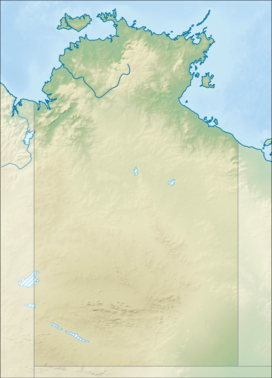
Back Uluru Afrikaans Uluru ALS أولورو Arabic اولورو ARZ Uluru Azerbaijani Улуру Byelorussian Улуру BE-X-OLD Улуру Bulgarian Uluru Breton Uluru Catalan
| Uluru | |
|---|---|
| Ayers Rock | |
 | |
| Highest point | |
| Elevation | 863 m (2,831 ft) |
| Prominence | 348 m (1,142 ft) |
| Coordinates | 25°20′42″S 131°02′10″E / 25.34500°S 131.03611°E |
| Naming | |
| Native name | Uluṟu (Pitjantjatjara) |
| Geography | |
| Geology | |
| Age of rock | 550–530 Ma |
| Mountain type | Inselberg |
| Type of rock | Arkose |
| Official name | Uluṟu-Kata Tjuṯa National Park |
| Criteria | v,vi,vii,ix |
| Reference | 447 |
| Inscription | 1987 (11th Session) |
 | |
Uluru (/ˌuːləˈruː/; Pitjantjatjara: Uluṟu [ˈʊlʊɻʊ]), also known as Ayers Rock (/ˈɛərz/ AIRS) and officially gazetted as Uluru / Ayers Rock,[1] is a large sandstone monolith. It outcrops near the centre of Australia in the southern part of the Northern Territory, 335 km (208 mi) south-west of Alice Springs.
Uluru is sacred to the Pitjantjatjara, the Aboriginal people of the area, known as the Aṉangu. The area around the formation is home to an abundance of springs, waterholes, rock caves and ancient paintings. Uluru is listed as a UNESCO World Heritage Site. Uluru and Kata Tjuta, also known as the Olgas, are the two major features of the Uluṟu-Kata Tjuṯa National Park.
Uluru is one of Australia's most recognisable natural landmarks[2] and has been a popular destination for tourists since the late 1930s. It is also one of the most important indigenous sites in Australia.
- ^ "Place Names Register Extract: Uluru / Ayers Rock". Northern Territory Place Names Register. Northern Territory Government. 6 November 2002. Retrieved 12 July 2013.
- ^ National Museum of Australia. "Defining Symbols of Australia - Uluru". www.nma.gov.au. Retrieved 11 February 2024.
© MMXXIII Rich X Search. We shall prevail. All rights reserved. Rich X Search

